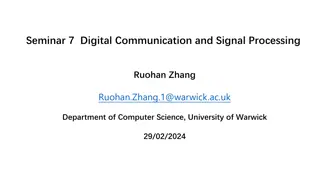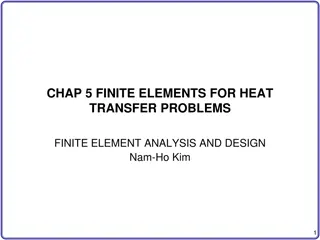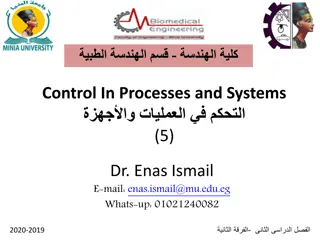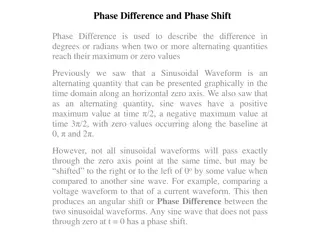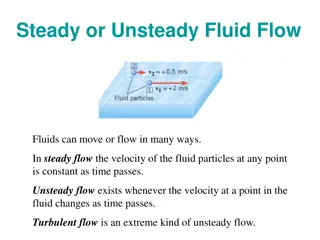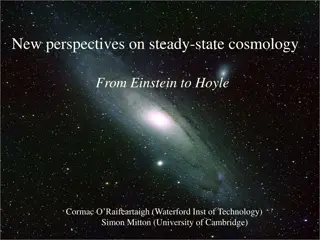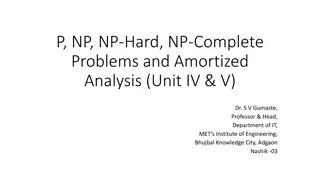Sinusoidal steady state problems
This content delves into the assumptions and consequences of sinusoidal steady-state conditions in electrical circuits. It covers the basics of voltage and current sources, phase and amplitude relations for resistors, capacitors, and inductors, and summarizes amplitude and phase relations in a concise manner.
Download Presentation

Please find below an Image/Link to download the presentation.
The content on the website is provided AS IS for your information and personal use only. It may not be sold, licensed, or shared on other websites without obtaining consent from the author.If you encounter any issues during the download, it is possible that the publisher has removed the file from their server.
You are allowed to download the files provided on this website for personal or commercial use, subject to the condition that they are used lawfully. All files are the property of their respective owners.
The content on the website is provided AS IS for your information and personal use only. It may not be sold, licensed, or shared on other websites without obtaining consent from the author.
E N D
Presentation Transcript
ENEE 205 Sinusoidal steady state problems PART 1: The basic assumptions and consequences
Sinusoidal Steady State (SSS) assumptions and consequences SINUSOIDAL ASSUMPTIONS Any and all voltage sources and current sources in a circuit have a sinusoidal time dependence, i.e. they have the form: v(t) = Vocos ( t+ v) or i(t) = Iocos( t+ I) If there is more than one source, they all have the same angular frequency . STEADY STATE ASSUMPTION The circuit was assembled so far in the past that all transient effects driven by initial conditions - have died out exponentially. (We will revisit this later.) SSS CONSEQUENCES Under SSS conditions, All voltages and currents in a circuit have a sinusoidal time dependence!
SSS Phase/amplitude relations for RESISTORS Due to SSS conditions, we can assume that: vR(t)=Vmcos( t+ v) iR(t)=Imcos( t+ i) Ohms Law then tells us that: vR(t)=Vmcos( t+ v)=RiR(t)=RImcos( t+ i) The only way this can be true for all times is if Vm=RImor Vm/Im=R and v= i So, the voltage and current are in phase and the ratio of the voltage magnitude to the current magnitude is the resistance R. iR(t) + R VR(t) -
SSS Phase/amplitude relations for CAPACITORS Due to SSS conditions, we can assume that: vC(t)=Vmcos( t+ v) iC(t)=Imcos( t+ i) The terminal relation for a capacitor tells us that: ic(t)= Imcos( t+ i)=Cdvc/dt=- CVmsin( t+ v) Or Imcos( t+ i)= CVmcos( t+ v+90 )* The only way this can be true for all times is if Im= CVmor Vm/Im= 1/ C and v= i-90 So, the voltage lags the current by 90 and the ratio of the voltage magnitude to the current magnitude is 1/ C. iC(t) + VC(t) - C *cos( + )=cos(A)cos(B)-sin(A)sin(B) So cos(A+90 ) =-sin(A) and cos(A-90 ) =+sin(A)
SSS Phase/amplitude relations for INDUCTORS Due to SSS conditions, we can assume that: vL(t)=Vmcos( t+ v) iL(t)=Imcos( t+ i) The terminal relation for an inductor tells us that: vL(t)= Vmcos( t+ v)=LdiL/dt=- LImsin( t+ i) Or Vmcos( t+ V)= LImcos( t+ i+90 )* The only way this can be true for all times is if Vm= LImor Vm/Im= L and v= i+90 So, the voltage leads the current by 90 and the ratio of the voltage magnitude to the current magnitude is L. iL(t) + VL(t) - L *cos( )=cos(A)cos(B)+sin(A)sin(B) So cos(A+90 ) =-sin(A) and cos(A-90 ) =+sin(A)
Summary of amplitude and phase relations Vphase Iphase ( V- I) Component Vmax / Imax (Vm/Im) Resistor R 0 1/( C) Capacitor -90 L Inductor 90
ENEE 205 Sinusoidal steady state Part 2: Complex Number Discussion
Complex Numbers number imaginary = j We define the 1 So, j2 = -1, j3 = -j, and j4 = +1. A general complex number can be written in Cartesian Form: Z = X + j Y, where X and Y are real numbers. We say Re { Z } = X (the real part of Z is X) Euler s Equation states (use Taylor Series expansion to prove): exp( j ) = cos ( ) + j sin ( ) From this we can write a complex number in exponential-polar form: Z = Zm exp( j ) We can convert from Cartesian (Z= X + j Y) to Exponential-Polar forms by X = Zmcos( ) and Y = Zmsin( ) or Zm = (X2 + Y2)1/2 and = arctan(Y/X)
COMPLEX NUMBER practice Let s say your complex number in Cartesian form is Z = 3 +4j Then in exponential form: |Z| = (32 + 42)1/2 = 5 and = tan-1(4/3) = 53.13 Z = 5ej53.13 Let s say your complex number in exponential form is Z = 13ej22.62 Then in Cartesian form: Z = 13 cos(22.62 ) +j 13 sin(22.62 ) = 12 + 5j.
ENEE 205 Sinusoidal steady state Part 3: Phasors
Phasors We will use Euler s Equation to simplify Terminal Relationships under SSS conditions: Since any SSS voltage in a circuit can be written as: V(t) = Vm cos( t + v) = Vm Re { exp[j( t + v)] } = Re {Vm exp[j( t + v)] } = Re {Vm exp(j v) exp(j t) } We define a PHASOR for any VOLTAGE or, likewise, any CURRENT in a circuit to be: j m and e V V = I = j I e V I m Given a phasor, we can find the corresponding time dependence by (the frequency is implicit): = = j j t j t ( ) Re{ } Re{ } v t V e V e e V m
Phasor practice Let s consider the usual outlet voltage in your house: V(t) = 120 2cos( t) V Then the phasor voltage would be: ? = 120 2??0 = 120 2 V (f = 60 Hz) The voltage that is used by your clothes dryer might be: V(t) = 208 2cos( t+120 ) V Then the phasor voltage would be: ? = 208 2??120 ? = 104 2 + ?104 6 V (f = 60 Hz) If the current driving your stereo is i(t) = 20cos(6283t+45 ) mA Then the phasor current would be: ? = 20??45 ?? = 10 2 + ?10 2 mA (f = 1 kHz)
More phasor practice Say that ? = 50 2???/4V and that =377 Rad/s. Find v(t). ? ? = ?? ????? = ?? 50 2??(? = 50 2cos ?? +? 4+??) = 50cos(??)-50sin(??) V 4 Finally, what if ? = 4 3? ??? (Still =377 Rad/s). One approach is first to convert to exponential polar form and then use the above formula, but one can find the time variation without the conversion: ? ? = ?? ?????= ?? ? cos ?? + ????(??) = ?? 4 3? cos ?? + ????(??) = ?? 4cos ?? + 3???(??) + ?(real stuff) ? ? = 4cos ?? + 3??? ?? ?? So, when the phasor is in Cartesian form, upon conversion, the real part multiplies cos( t) and the imaginary part multiplies sin( t).
ENEE 205 Sinusoidal steady state Part 4: Impedance and Admittance
Impedance and Admittance The IMPEDANCE of any passive component is the ratio of the phasor voltage across the passive component to the phasor current entering the component (under SSS conditions, using the passive sign convention). The units are Ohms. I + The ADMITTANCE of any passive component is the ratio of the phasor current entering the component to the phasor voltage across the passive component. So Y = 1/Z and the units are Mhos. V These quantities essentially represent the Sinusoidal Steady State equivalent of the terminal relationships.
Impedance and admittance for Resistors Ohms Law then tells us that: vR(t)=Vmcos( t+ v)=RiR(t)=RImcos( t+ i) The only way this can be true for all times is if Vm=RImor Vm/Im=R and v= i So, the voltage phasor and current phasor are: ? = ?????? and ? =?? iR(t) + ????? R VR(t) - And 1 ?= ? ? ? = ? or ? = ? ? = ? = So, for resistors, the impedance is just the resistance and G is called the conductance!
Impedance and admittance for Capacitors The terminal relation for a capacitor tells us that: ic(t)= Imcos( t+ i)=Cdvc/dt=- CVmsin( t+ v) Or Imcos( t+ i)= CVmcos( t+ v+90 )* The only way this can be true for all times is if Im= CVmor Vm/Im= 1/ C and i= v+90 So, the voltage phasor and current phasor are: ? = ?????? and ? = C????(??+90 ) And ? ? =? ?90 C and ? = ? ? = ? C iC(t) + VC(t) - C = ? C= 1 ? = ? C
Impedance and admittance for Inductors The terminal relation for an inductor tells us that: vL(t)= Vmcos( t+ v)=LdiL/dt=- LImsin( t+ i) Or Vmcos( t+ V)= LImcos( t+ i+90 )* The only way this can be true for all times is if Vm= LImor Vm/Im= L and v= i+90 So, the voltage phasor and current phasor are: ? = ?????? and ? = And ? = ? ? = ???90 = ? ? and ? = ? ? = 1/? ? iL(t) + (?? ?)??(?? 90 ) VL(t) - L
Summary of impedances and admittances Impedance ( ) Component Vmax / Imax (Vm/Im) Vphase Iphase ( V- I) Admittance (1/ ) R = R e j0 Resistor R 0 G = 1/R 1/( C) 1/(j C) = e -j90 /( C) j C Capacitor -90 L j L= e j90 L 1/(j L) Inductor 90
ENEE 205 Sinusoidal steady state Part 5: Simplifying circuits combining passive components connected by trivial nodes or meshes
Simplifying passive circuits Whenever one has some passive network that connects to the rest of the circuit via two terminals, a generalized definition of impedance can be used to replace the passive network with a single passive branch. The impedance is defined to be the phasor voltage across those two terminals divided by the phasor current entering the terminal denoted the positive reference for voltage. General techniques for simplifying passive circuits is the subject of the next module; on the following slides we will look only at two simple, but very useful, configurations.
Series RLC branch impedance KVL for the RLC network connected by trivial nodes (in the time domain): ? ? + ??? + ??? + ??? =0 It turns out that the KVL equation is the same in the phasor domain, if we replace time-dependent voltages with their phasor counterparts: L I R + + vR -+ vL - + V C vC - I + Z=R+j L-j/( C) ??+ ??+ ??= ? V Now we can plug in impedances, noting that the trivial nodes mean that all components have the same current flowing through them: ? ? + ??? ? + ?/??? = ? or ? = ? ? =? + ??? ?/??
parallel RLC branch admittance I KCL for the RLC network connected by trivial meshes(for lower node): ? ? + ??? + ??? + ??? =0 It turns out that the KCL equation is the same in the phasor domain, if we replace time-dependent currents with their phasor counterparts: + V R L C iC iL iR I + Y=1/R+j C-j/( L) ??+ ??+ ??= ? V Now we can plug in admittances, noting that the trivial meshes mean that all components have the same voltage across them: ? ? + ?/??? + ??? ? = ? or ? = ? ? =1/? + ??? ?/??
ENEE 205 Sinusoidal steady state Part 6: What s in the box problems
Definitions R=resistance G=conductance Z=R+jX; Y=G+jB; X=reactance B=susceptance Z=1/Y=R+jX=1/(G+jB)=(G-jB)/(G2+B2) So: Or R = G/(G2+B2) and X = -B/(G2+B2) Y=1/Z=G+jB=1/(R+jX)=(R-jX)/(R2+X2) So G = R/(R2+X2) and B = -X/(R2+X2)
Whats in the box? When a voltage source: v(t) =10 cos(1,000,000t) V is connected to mystery the box shown on the right, the current flowing into the box is measured to be: i(t) = 200 cos(1,000,000t-20 ) mA. If the box contains a series combination of two passive components, what are the values of the components in the box? DRAW a picture of the circuit and label the component values clearly! ?
Series RL and RC circuits A series network is a collection of components all connected by trivial nodes. We saw that a series RLC circuit had the equivalent impedance: ? = ? + ??? ?/?? So, a series RL branch (no capacitor) would have: ? = ? + ??? = ? + ??,? ??? ? > 0 and, a series RC branch (no inductor) would have: ? ??= ? + ??,? ??? ? < 0 ? = ?
Solving Whats in the box problems To solve these problems we need to use the definition of impedance: ? = We need to convert v(t) and i(t) into phasors, and then write the ratio in Cartesian form: ? ? = A + jB = ? + ??? ? ?/?? So, irrespective of the sign of B. the real part of to the resistance in the box. If B>0, then, by equating imaginary parts, the other component is an inductor and L = B/ . However, if B<0, then the other component is a capacitor, and C = -1/( B) ? ? ? + ? - ? ?? ? > 0 ?? ? < 0 ? ?, A, is equal
Solving our Whats in the box problem The parameters for the problem are: v(t) =10 cos(1,000,000t) V i(t) = 200 cos(1,000,000t-20 ) mA. So, =106 Rad/s, ? = 10? and ? = 0.2? ?20 A, ? ?= 50??20 = 50cos 20 + 50?sin 20 = 47 + ?17.1 Hence, there is a series RL in the box, and ? + ??? = ? + ?106? = 47 + ?17.1 So, ? = 47 And ?106? = ?17.1 so L=17.1 H Thus,
Solving a different Whats in the box? What if the parameters for the problem were: v(t) =10 cos(1,000,000t) V i(t) = 200 cos(1,000,000t+20 ) mA. Then, =106Rad/s, ? = 10? and ? = 0.2?+?20 A, ? ?= 50? ?20 = 50cos 20 50?sin 20 = 47 ?17.1 Then it would be a series RC in the box, and ? ??= ? So, ? = 47 And 106? = 1/17.1 so C=58 nF Thus, ? ? 106?= 47 ?17.1
ENEE 205 Sinusoidal steady state Part 7: Finding the complete set of algebraic equations needed to solve a Sinusoidal Steady-State problem.
Algorithm for solving complete sets of sinusoidal steady state equations Step 0 Obtain circuit Step 1 Convert to phasor domain: write impedances/ admittances and phasor values on circuit drawing - combine passive components if applicable. Step 2 Label nodes and meshes (Find B, N, M) Step 3 Assign reference directions Step 4 Write B KLs Step 4a Write N-1 KCLs Step 4b Write M KVLs Step 5 Plug admittances into KCLs OR plug impedances into KVLs (follow instructor s directions) Step 6 Solve B algebraic equations! Step 7 Box Answer!
Step 0 - Obtain circuit 4cos(2t) V 0.5 F 3 H 3sin(2t) V 3 2 H 3 F 0.1 H 4
Step 1 convert to phasors -j 6j 4 V 4j -j/6 3 -3j V 0.2j 4
Step 1b simplify if possible 4 V 5j -3j V -j 3 4(1+j)
Step 2 - Label nodes and meshes 4 V 5j C A B -3j V -j 3 II 4(1+j) III I D
Step 3 Assign Reference Directions C + V2 - - 4 V + i1 A B i2 5j + + + 4(1+j) -3j V 3 -j V5 V3 V4 - I - - II III i3 i4 i5 i6 D
Step 4a Write N-1 KCLs C + V2 - - 4 V + i1 A B i2 5j + + + 4(1+j) -3j V 3 -j V5 V3 V4 - I - - II III i3 i4 i5 i6 D KCL A: ?1 ?3= 0 B: ?1 ?2 ?4= 0 C: ?2 ?5 ?6= 0
Step 4b Write M KVLs C + V2 - - 4 V + i1 A B i2 5j + + + 4(1+j) -3j V 3 -j V5 V3 V4 - I - - II III i3 i4 i5 i6 D KVL I: ?3 4? + ?4= 0 II: ?4+ ?2+ ?5= 0 III: ?5 3?? = 0
Step 5 Plug Impedance/Admittance into KLs C + V2 - - 4 V + i1 A B i2 5j + + + 4(1+j) -3j V 3 -j V5 V3 V4 - I - - II III i3 i4 i5 i6 D KVL I: ?3 4? + ?4= 0 II: ?4+ ?2+ ?5= 0 III: ?5 3?? = 0 I: j?3+ 4 1 + ? ?4= 4? II: 4 1 + ? ?4+ 5??2+ 3?5= 0 III: 3?5= 3??
Step 6 Solve equations One can use the trivial nodes and meshes, KCL A and KVL III, to reduce the number of equations to 4. Also ?6 only appears in C, so we can get to three simultaneous equations to solve. A: ?1= ?3 B: ?1 ?2 ?4= 0 C: ?2 ?5 ?6= 0 I: j?3+ 4 1 + ? ?4= 4? II: 4 1 + ? ?4+ 5??2+ 3?5= 0 III: 3?5= 3?? B: ?1 ?2 ?4= 0 C: ?2 ?6= ?? I: j?1+ 4 1 + ? ?4= 4? II: 4 1 + ? ?4+ 5??2= 3??
Solving equations, part 2 B: ?1 ?2 ?4= 0 I: j?1+ 4 1 + ? ?4= 4? II: 4 1 + ? ?4+ 5??2= 3?? The three equations can be written in matrix form 1 1 0 5? 1 ?1 ?2 ?4 0 4 3? ? 0 4 + 4? 4 4? = The matrix then can be solved numerically (e.g. with MATLAB), or by matrix inversion, Gaussian elimination. Kramer s Rule, etc.
Gaussian elimination 1 1 0 5? 1 ?1 ?2 ?4 0 4 3? ? 0 4 + 4? 4 4? = 1 0 0 1 ? 5? 1 ?1 ?2 ?4 0 4 3? 4 + 3? 4 4? = 1 0 0 1 ? 0 1 ?1 ?2 ?4 0 4 4 + 3? 16 + 11? = 20 + 3?
Gaussian elimination, part 2 1 0 0 1 ? 0 1 ?1 ?2 ?4 0 4 4 + 3? 16 + 11? = 20 + 3? 0 4? ?1 ?2 ?4 1 0 0 1 1 0 1 = 4? 3 1 20 + 3? / 16 + 11? Calculate ?4 first and then backfill to get ?2 and then ?1. ?2+ ?4 ?1 ?2 ?4 4? (4? 3)?4 (20 + 3?)/(16 + 11?) =
ENEE 205 Sinusoidal steady state Part 8: RMS voltage and current, average power, and the power factor
Root-mean-square (RMS) voltages and currents For sinusoidal steady-state, the average value of a voltage or current is zero, so we characterize voltages/currents by their RMS values instead: 1 T 1 T T T = = 2 2 ( ) ( ) where T is the period V v t dt I i t dt rms rms 0 0 1 T T = 2 ( ) V v t dt rms 0 1 T T = + 2 2 cos ( ) V t dt m v 0 2 V T = (1 cos(4 + t T + = 2 / / 2 ) because m T dt T v 2 0 = = / 2 likewise / 2 V V I I rms m rms m
Average power dissipated in a branch 1 T T = ( ) ( ) P v t i t dt Where T is the period av 0 1 T T = + + cos( ) cos( ) V t I t dt m V m I 0 I V T = + + + cos( 2 ) cos( ) m m t dt V I V I 2 T 0 V I = = cos( ) cos( ) m m V I V I rms rms V I 2 I V V 1 1 V I = = = ( ) j j j * Re Re Re m m e I e e V V I I m m 2 2 2 : 1 cos( ) + is called A the B POWER = FACTOR! note V I + 2 : cos( ) cos( ) 2 cos( ) cos( ) note A B A B
Power factor correction example Let s find the power factor for the source in the figure to the left. KVL says that (in phasor form): ??= ??+ ?? KCL says that (since all nodes are trivial): ??= ??= ?? So, inserting impedances into the KVL equation: ??= ? ??+ ??? ?? Or, iR + vR - iS + vS - iL + vL - ?? ??=?? ?2+ ?2?2????? 1(?? ?) ??(?? ??)= ? + ??? = ?? ?? ? ? So, cos ?? ?? = cos ??? 1 = ?2+?2?2
Use a capacitor to correct the power factor! KVL still says: ??= ??+ ??= ?? KCL now says: ??= ??+ ?? and ??= ?? So, adding in terminal relationships gives: ??= ? ??+ ??? ??= ??/(j ?) Or, + vL - iS iR + vR - iC + vS - + vc - iL ?? ??= ? + ??? ??? ??= j ? ?? ??? ??? ?2+ ?2?2+ j ? ?? ??= ??+ ??= ? ? ?? ??= ?2+ ?2?2+ ?? ? ?2+ ?2?2 ?? ??must be real, so choose ? (?2+?2?2) To correct the power factor to one, ? =
Average power summary So there are three main formulas to calculate average power (besides integration), and they are: ???=???? cos ?? ?? = ????????cos ?? ?? =1 2?? ? ? 2 To solve a problem, one should use whichever formula is most convenient. v- I 0 cos( ( v- I) 1 component Average power Resistor R Vrms Irms 0 Capacitor C -90 0 Inductor L 90 0 0 Arctan( L/R) R/(( L)2+R2)1/2 Vrms IrmsR/(( L)2+R2)1/2 RL branch



